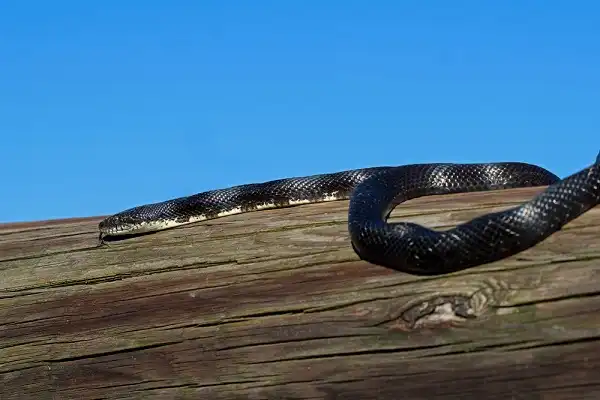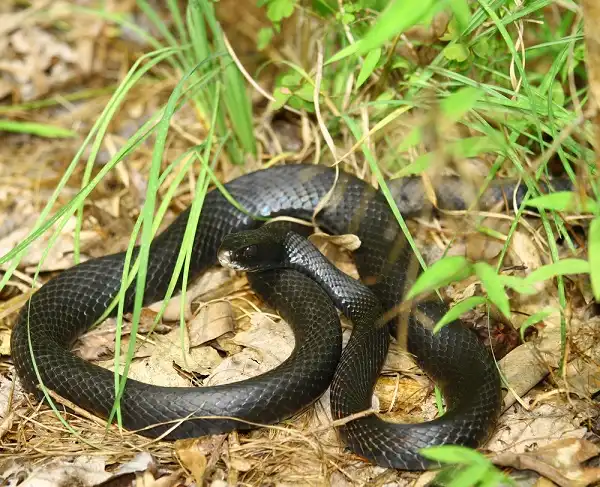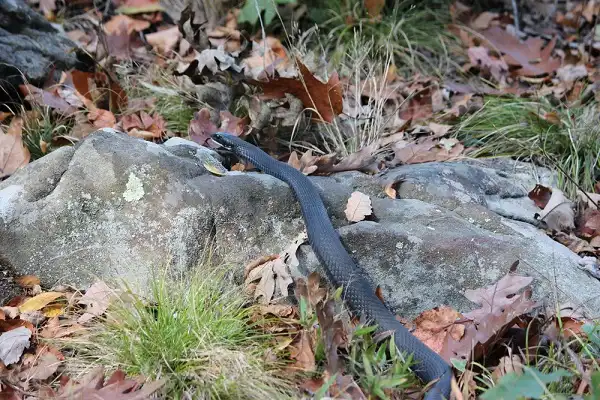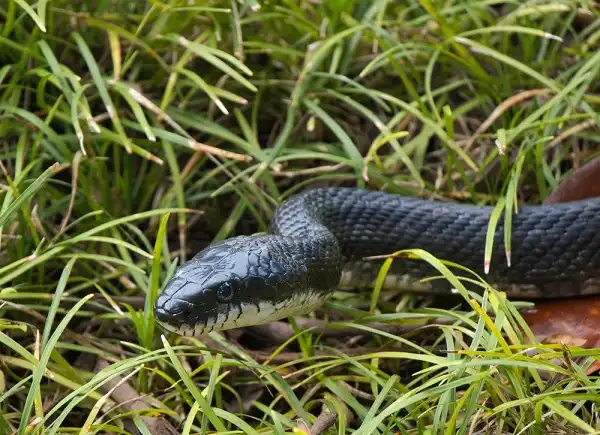Eastern Rat Snakes, also known as black rat snakes or pilot black snakes, are common across the eastern United States and southeastern Canada. This fascinating species is extremely variable in size, coloration, and even behavior depending on their geographic location, making them an incredibly diverse species with unique adaptations that enable survival in variable environments. In this blog post, we’ll explore why Eastern Rat Snake populations remain strong (even despite urbanization) and learn how best to co-exist peacefully with these amazing animals if you choose to attract them onto your property!

Eastern Rat Snake Description
The Eastern Rat Snake, scientifically known as Pantherophis alleghaniensis, is a non-venomous Colubrid snake species native to eastern North America. They are also referred to as the black rat snake or pilot black snake due to their black scales that have a shiny appearance. The Eastern Rat Snake’s diet mainly consists of small mammals, birds, and their eggs. They are excellent predators and have been known to take down prey larger than their own size. Given their hunting habits, Eastern Rat Snakes play a critical role in controlling rodent populations, making them an important part of the ecosystem. In terms of physical characteristics, Eastern Rat Snakes have smooth scales that are arranged in a distinct pattern. The scales on their underside are lighter in color than those on their back, which helps them blend in with their surroundings. They also have pointed head and slender body that allows them to move quickly and efficiently through their environment.
Eastern Rat Snake Habitat
The habitat of Eastern Rat Snakes is quite diverse, as they are found across a large portion of eastern North America. They can be found in a variety of environments, including woodlands, forests, farmlands, swamps, marshes, and even suburban and urban areas. In forested areas, they tend to be found near bodies of water or in rocky outcroppings that offer shelter and a good source of prey. In open fields and farmlands, they are often found in fence rows or hedgerows, where they can easily climb to get a better view of their surroundings. When it comes to shelter, Eastern Rat Snakes often depend on vertical structures like trees, shrubs, and rocks to climb and hide in. These structures also serve as potential hunting grounds, where they can catch prey like small mammals and birds.
Eastern Rat Snake Diet
Eastern Rat Snakes have a diverse diet that consists primarily of small mammals, birds, and their eggs. These snakes are excellent predators and are known to take down prey larger than their own sizes, such as rabbits, squirrels, and even young deer. They are also opportunistic predators and will eat whatever prey is available, including frogs, lizards, and insects. Interestingly, the diet of Eastern Rat Snakes changes with the seasons. In the spring, when rodents become more active, they constitute the majority of the snakes’ diet. During the summer, birds and their eggs become a more important food source, as many birds begin nesting during this time. In the fall, the snakes shift back to rodents, as they become more active in preparation for the winter months. By preying on rodents and other small mammals, Eastern Rat Snakes play a critical role in controlling rodent populations, which can cause damage to crops and spread disease. Therefore, they are an important part of the ecosystem and should be appreciated for their contributions.

Eastern Rat Snake Size
Eastern Rat Snakes are one of the largest species of snakes found in North America, with individuals measuring up to 6 feet in length. However, they are not always that long, and their size can vary depending on several factors, including their habitat, diet, and genetics. Eastern Rat Snakes are also known for their impressive strength and agility. They are expert climbers and are capable of scaling trees, rocks, and other vertical structures with ease. This agility allows them to access prey and shelter that other animals cannot, expanding their hunting grounds and enhancing their chances of survival. In terms of their weight, Eastern Rat Snakes can weigh anywhere from 1 to 5 pounds, depending on their length and body type. Hatchlings are typically around 8 to 12 inches long and weigh just a few grams. As they grow, they shed their skin several times a year, which allows them to adapt to changes in size and shape.
Eastern Rat Snake Lifespan
Eastern Rat Snakes are known for their resilience and ability to adapt to different habitats and food sources. With a lifespan of up to 20 years in the wild, these snakes are among the longest-lived of all North American snakes. During their lifetime, Eastern Rat Snakes undergo several developmental stages. Hatchlings are born after an incubation period of about 2 months and measure eight to twelve inches in length. They are completely independent of birth and begin hunting for small insects and other prey soon after hatching. As they grow, their diet expands to include larger prey, such as rodents, frogs, and birds. They shed their skin several times a year during this period, helping them to adapt to their changing size and shape. Once Eastern Rat Snakes reach adulthood, their focus is on mating and reproducing. Male snakes are known for their territorial behavior during the breeding season, which typically occurs in the spring or early summer. They use a combination of chemical signals and aggressive displays to attract females and discourage rival males. After mating, female Eastern Rat Snakes lay a clutch of eggs, which are typically hidden in soil or leaf litter. The eggs hatch after another two-month incubation period, and the cycle begins anew.
Eastern Rat Snake Behavior
Eastern Rat Snakes are known for their unique behavior, which ranges from hunting techniques to mating displays. These adaptable snakes use a combination of physical and chemical signals to communicate with one another and navigate their surroundings. One fascinating aspect of Eastern Rat Snake’s behavior is their hunting strategy. These snakes are expert climbers and often use their agility to track down prey in trees and tall grasses. They have also been known to raid bird nests for eggs and small chicks, using their sharp teeth and powerful jaws to break through shells and feathers. In addition to their hunting prowess, Eastern Rat Snakes are also skilled at avoiding danger. When confronted by a predator or other perceived threat, these snakes will often freeze in place and spread their body out to appear larger and more intimidating. They may also emit a foul-smelling musk from their glands to deter attackers. During the mating season, male Eastern Rat Snakes become highly territorial and aggressive. They use a combination of pheromones and visual displays to signal their presence to females and warn off rival males. Some male Eastern Rat Snakes have even been known to engage in combat, wrestling one another for dominance and the right to mate.

Eastern Rat Snake Speed
Eastern Rat Snakes are known for their impressive speed, strength, and stamina. These adaptable snakes can move quickly over land or through water in search of food or shelter. Depending on the terrain and its prey, an Eastern Rat Snake can travel up to 2 miles per hour (3.2 km/h). When swimming, Eastern Rat Snakes use their long tails to propel themselves forward in fluid strokes. This makes them exceptionally fast swimmers and allows them to traverse large bodies of water with ease. On land, these snakes rely on their strong muscles to launch themselves forward with quick bursts of speed. Ultimately, Eastern Rat Snakes are some of the most impressive and adaptable animals in North America. With their speed, strength, and stamina, these resilient snakes continue to surprise us with their remarkable abilities. As we learn more about them, we become increasingly aware of how important they are for controlling rodent populations and preserving the ecological balance in our environment.
Eastern Rat Snake Hunting
Eastern Rat Snakes are skilled hunters that primarily prey on rodents, birds, and amphibians. To catch their prey, they use a variety of tactics and adaptations. Another approach used by Eastern Rat Snakes is to actively pursue their prey. They use their keen sense of smell and excellent eyesight to track down potential meals and then employ their agility and speed to catch them. For example, when hunting birds, they may climb trees and navigate quickly between branches to catch them by surprise. Eastern Rat Snakes have several adaptations that make them effective hunters. For example, their flexible jaws allow them to swallow prey whole, while their sharp teeth help them to grasp and hold onto their prey during the struggle.
In addition, their powerful muscles and strong coils help them to suffocate and immobilize their prey. Eastern Rat Snakes are also able to eat a wide variety of foods, which makes them well-suited to their changing environments. For example, they are known to eat crickets, grasshoppers, and other insects when their preferred food sources are scarce. Despite their success as hunters, Eastern Rat Snakes face numerous challenges in the wild. Loss of habitat and prey, as well as hunting by humans and other predators, can all impact their survival. Fortunately, conservation efforts and education about their important role in the ecosystem can help ensure the continued existence of these remarkable creatures.

Conclusion
Eastern Rat Snakes are highly adaptable reptiles that can be found in a variety of environments. They have impressive speed and agility, which helps them to catch their prey with surprising efficiency. In addition, they possess numerous adaptations such as flexible jaws and sharp teeth for capturing and subduing prey. Despite the challenges they face in the wild, conservation efforts and education about their important role in the ecosystem can help ensure these remarkable creatures continue to exist for future generations.
Frequently Asked Question


